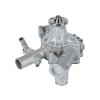This new title features the published papers of Professor and a host of high profile speakers, originally presented at the Swansea International Colloquium on Marine Insurance Law 2005. Maritime Insurance examines and analyzes in-depth specific issues that are currently occupying the marine insurance markets and the law.
The issues identified in this book are the fundamental issues on which marine insurance law is based, and of which are in the process of being re-examined and developed further to respond to the needs of modern insurance practice.
The purpose of this text is to complement more general textbooks by delving more deeply into contemporary issues and thereby offering solutions rather than an introduction to problems.
INSURANCE FOR OCEAN TRANSPORTATION
Ⅰ. In the international trade, the insurance is an indispensable condition and sector. Specially, it is ocean insurance for ocean transportation that has the largest business and the widest coverage.
Ⅱ. The insurance for ocean transportation can be mainly inclusive of two kinds, namely, the Main Risk and the Added Risk.
1. The Main Risk includes F.P.A. (i.e. Free from Particular Average), W.A. (i.e. With Particular Average) and All Risks.
1) Responsibility Range of F.P.A.
A. The whole damage or presumed whole damage on the group of insured cargo caused by natural disaster during the transportation. Such insured cargo is loaded on barge leaving for or from vessel. The cargo loaded on each barge can be regarded as a whole group.
B. The whole or partial damage on cargo caused by the accident on the means of transportation.
C. The whole damage caused by dropping into sea due to natural calamity before or after accident occurs on the means of transportation.
D. The whole or partial damage caused by one or several piece of cargo dropping into sea during loading and unloading or transshipping.
E. The reasonable cost caused by the measures that insurant undertakes, such as salvaging the cargo under the coverage and avoiding or minimizing any damage. However, the maximum of cost must not be more than the insurance amount for the salvaged cargo.
F. The damage and the special cost caused by unloading, storage and transportation in ports of distress and midway ports after the means of transportation are wrecked.
G. The cost caused by sacrifice, share and salvage in general average.
H. The compensation the consignors pay the carriers as per “the responsibility clause of the conflict between vessels” on the transportation contract.
2) Responsibility Range of W.A.
Including every responsibility of F.P.A., and partial damage on the insured cargo caused by natural calamity
3) Responsibility Range of All Risks
Including every responsibility of F.P.A. and W.A., and the whole or partial loss on insured goods caused by general outside reasons during the transportation.
2. The kind of added risk is the extension and supplement to the responsibility for the kinds of Main Risks, but can not be insured separately. The added risk is inclusive of two kinds, the general one and the specific one. To be more exact, the general added risk includes the below eleven sorts:
1) T.P.N.D (Risk of Theft, Pilferage and Nondelivery)
2) F.R.W.D. (Risk of Fresh Water Rain Damage)
3) Risk of Shortage
4) Risk of Leakage
5) Risk of Intermixture and Contamination
6) Risk of Clash & Breakage
7) Risk of Odour
8) Risk of Sweating & Heating Damage
9) Risk of Hook Damage
10) Risk of Packing Breakage
11) Risk of Rust
Specific Added Risk includes
1) Risk of Failure to Deliver
2) Risk of import Duties
3) Deck Risk
4) Rejection Risk
5) Aflatoxin Risk
6) Risk of the interests of Seller
7) Fire Risk Extension Clause for Storage of Cargo at destination Hongkong, including Kowloon, or Macao
8) Strikes Risk
9) War Risk in Shipping
Ⅲ. Term of Insurance Responsibility
As per the international convention on the insurance, the Main Risk is based on “Warehouse to Warehouse Clause”. Namely, the insurance responsibility is in effect from the time that the insured cargo leaves the warehouse or storehouse of shippers at the origin mentioned on the insurance policy, including the common transportation at sea, river and land, until the insured cargo arrives at the warehouse of consignee at the destination, nevertheless, the expiration time will be 60 days after the cargo is unloaded from the vessel at maximum. The general added risk is included in the responsibility of All Risks, so it is unnecessary to insure any general added risk other than All Risk. However Insuring All Risks is not meant to be responsible for all the losses caused all risks. The responsibility coverage of specific added risk for War Risk in Shipping includes the loss and damage caused by the war, the similar actions to war, hostilities, military conflicts or buccaneering, such as the adverse consequence on the cargo because of capture, detention, arrest, inhibition, detainment. In addition it also includes the loss and damage caused by a variety of conventional weapons, like water mine, torpedo and bomb, and caused by the cost of sacrifice, share and salvage required by the General Average due to the above reasons. However, it is not responsible for the damage and cost caused by nucleus weapons, such as atom bomb and h-bomb. In any case the responsibility coverage of war risk is limited to the risk on the water, to be more exact, it is valid from the time that the cargo is loaded on the board of vessel or barger, until the time that it is unloaded at the destination. If the cargo is not unloaded from the vessel or barger, the insurance responsibility will expire automatically 15 days after the midnight that the vessel arrives at the destination port. Moreover it is also stipulated in the insurance clauses that you needn’t pay any charge in insuring the Strike Risk on top of War Risk.
Ⅳ. Exception Responsibility for the Kinds of Main Risks
It is referred to the loss and costs beyond the insurance coverage, usually belonging to the non-accidental, non-occasional or specially insured risk. In order to clarify the responsibility coverage of the insurant, PICC (i.e. People Insurance Corporation of China) identifies the following five damages and cost as the exception responsibility for the kinds of Main Risks.
1. The damages caused by the intended actions or defects
2. The damages caused by the liabilities of the shippers
3. The damages on the insured cargo caused by the badness in quality and the shortage in quantity before the effectiveness of insurance responsibility
4. The damages or costs caused by the nature spoiling, the essence disfigurement, the attributes, the dropping on markets, the delay in transportation
5. The responsibility and exception responsibility stipulated in the clauses of War Risk and Strike Risk for ocean transportation
The exception responsibility for the kinds of Main Risks for ocean transportation is almost the same as that for other transportation by air, truck or post.






